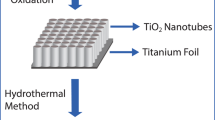Abstract
The morphology of photoanode materials strongly affects the photovoltaic performance of dye-sensitized solar cells. TiO2 nanoparticles possess excellent dye adsorption capability. However, they show low electrical conductivity. Moreover, the penetration of electrolyte into pores of mesoporous TiO2 also promotes recombination reaction. In this work, one-dimensional TiO2 nanotubes (TNTs) have been synthesized by the hydrothermal method. The synthesis was carried out at a hydrothermal temperature of 150 °C and then annealed at 600 °C. The TiO2 nanotubes were characterized by scanning electron microscopy and X-ray diffraction analysis. The photoanode was prepared by depositing TNTs on the conductive glass substrates in the paste form and then annealed at 450 °C. Poly(vinylpyrrolidone) acts as a binder and its amount was optimized in the paste for the best Photovoltaics performance of solar cell. The DSSC with TNTs based photoanode showed higher efficiency (7.53%) compared to the TiO2 nanoparticles-based device (5.88%).



Similar content being viewed by others
References
Ahmad, W.; Mehmood, U.; Al-Ahmed, A.; Al-Sulaiman, F.A.; Aslam, M.Z.; Kamal, M.S.; Shawabkeh, R.A.: Synthesis of zinc oxide/titanium dioxide (ZnO/TiO2) nanocomposites by wet incipient wetness impregnation method and preparation of ZnO/TiO2 paste using poly(vinylpyrrolidone) for efficient dye-sensitized solar cells. Electrochim. Acta. 222, 473–480 (2016). https://doi.org/10.1016/J.ELECTACTA.2016.10.200
Lee, C.H.; Kim, K.H.; Jang, K.U.; Park, S.J.; Choi, H.W.: Synthesis of TiO 2 nanotube by hydrothermal method and application for dye-sensitized solar cell. Mol. Cryst. Liq. Cryst. (2011). https://doi.org/10.1080/15421406.2011.566078
Kambe, S.; Nakade, S.; Kitamura, T.; Wada, Y.; Yanagida, S.: Influence of the electrolytes on electron transport in mesoporous TiO2-electrolyte systems. J. Phys. Chem. B. 106, 2967–2972 (2002). https://doi.org/10.1021/jp013397h
Sun, K.C.; Qadir, M.B.; Jeong, S.H.: Hydrothermal synthesis of TiO2 nanotubes and their application as an over-layer for dye-sensitized solar cells. RSC Adv. 4, 23223–23230 (2014). https://doi.org/10.1039/c4ra03266g
Karim, N.A.; Mehmood, U.; Zahid, H.F.; Asif, T.: Nanostructured photoanode and counter electrode materials for efficient dye-sensitized solar cells (DSSCs). Sol. Energy. 185, 165–188 (2019). https://doi.org/10.1016/J.SOLENER.2019.04.057
Sharmoukh, W.; Allam, N.K.: TiO 2 nanotube-based dye-sensitized solar cell using new photosensitizer with enhanced open-circuit voltage and fill factor. ACS Appl. Mater. Interfaces. 4, 4413–4418 (2012). https://doi.org/10.1021/am301089t
Roy, P.; Albu, S.P.; Schmuki, P.: TiO2 nanotubes in dye-sensitized solar cells: Higher efficiencies by well-defined tube tops. Electrochem. commun. 12, 949–951 (2010). https://doi.org/10.1016/j.elecom.2010.04.029
Luo, D.; Liu, B.; Fujishima, A.; Nakata, K.: TiO2 nanotube arrays formed on Ti meshes with periodically arranged holes for flexible dye-sensitized solar cells. ACS Appl. Nano Mater. 2, 3943–3950 (2019). https://doi.org/10.1021/acsanm.9b00849
Adachi, M.; Murata, Y.; Okada, I.; Yoshikawa, S.: Formation of titania nanotubes and applications for dye-sensitized solar cells. J. Electrochem. Soc. 150, G488 (2003). https://doi.org/10.1149/1.1589763
Lee, T.H.; Ryu, H.; Lee, W.J.: Fast vertical growth of ZnO nanorods using a modified chemical bath deposition. J. Alloys Compd. 597, 85–90 (2014). https://doi.org/10.1016/j.jallcom.2014.02.003
Meng, Y.; Lin, Y.; Yang, J.: Synthesis of rod-cluster ZnO nanostructures and their application to dye-sensitized solar cells. Appl. Surf. Sci. 268, 561–565 (2013). https://doi.org/10.1016/j.apsusc.2012.12.171
Shah, L.A.; Malik, T.; Siddiq, M.; Haleem, A.; Sayed, M.; Naeem, A.: TiO2 nanotubes doped poly(vinylidene fluoride) polymer membranes (PVDF/TNT) for efficient photocatalytic degradation of brilliant green dye. J. Environ. Chem. Eng. 7, 103291 (2019). https://doi.org/10.1016/j.jece.2019.103291
Lim, Y.C.; Zainal, Z.; Hussein, M.Z.; Tan, W.T.: the effect of heat treatment on phase transformation, morphology and photoelectrochemical response of short Tio 2 nanotubes. Dig. J. Nanomater. Biostruct. 8(1), 167–176 (2013)
Acknowledgements
The authors acknowledge the support provided by PPE department, UET Lahore.
Author information
Authors and Affiliations
Corresponding author
Rights and permissions
About this article
Cite this article
Babar, F., Mehmood, U., Nazar, R. et al. Hydrothermal Synthesis of TiO2 Nanotubes and Preparation of Paste Using Polyvinylpyrrolidone (PVP) as a Binder for The Photoanode of Dye-Sensitized Solar Cells (DSSCs). Arab J Sci Eng 47, 6379–6383 (2022). https://doi.org/10.1007/s13369-021-06362-4
Received:
Accepted:
Published:
Issue Date:
DOI: https://doi.org/10.1007/s13369-021-06362-4




